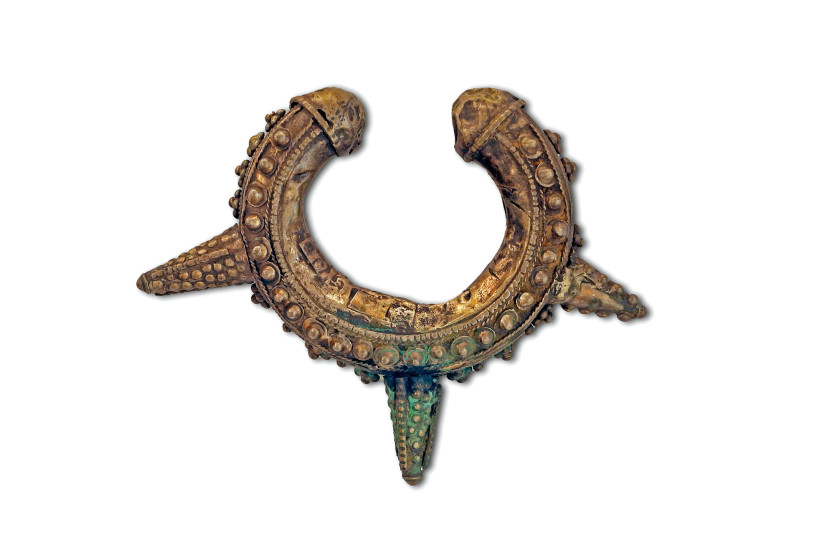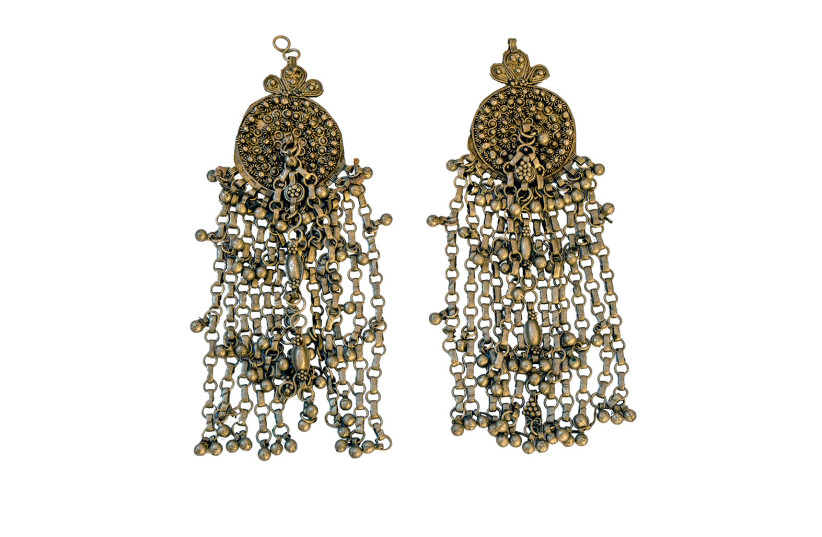What does the average Israeli know about Yemenite Jewish culture?
Ask anyone who has been around these parts for, say, over 30 years, and that might conjure up images of young men beating out mesmerizing lilting percussive grooves on discarded olive containers. Then again, one’s mind may be cast back to the alluring figure of late celebrated singer Ofra Haza, particularly to her 1984 album Yemenite Songs. The record not only introduced a global audience to the works of 17th-century poet Rabbi Shalom Shabazi and catapulted Haza to international stardom, but it also gave us some idea of the nature of traditional Yemenite garb that she donned for the photo shoot.
That lies at the core of a new exhibition that opened yesterday at the Museum for Islamic Art. The show goes by the alluring title of “You are Beautiful, My Love” and displays some of the exquisite gems produced by the Yemenite jewelry sector over the centuries.
Delicacy, filigree finery and intricate crafting are just some of the properties one could attach to the wonderfully aesthetic accessories in the display cabinets at the museum. The full name of the exhibition includes the explanatory complement Bridal Jewelry from Yemen.

All the enchanting artifacts come from the collection of Yoel Shagan, which was inherited by his son, art collector Ofer Shagan, who has now bequeathed them to the museum in memory of Yoel’s mother, Nehama Bat-Shalom Dahari, and grandmother Sarah Dahari.
What can we learn about Yemenite Jewish culture at the exhibition?
THE NEW museum collection comprises what is described as “an intimate” showing but, nonetheless, manages to impart much of the richness of the culture in question and the incredible craftsmanship and manual dexterity required to produce the creations.
Idit Sharoni, who put the exhibition together, says she was more than happy to take the pieces on board. “As a museum curator, it is something special to receive a collection of jewelry. You sometimes get something somebody wants to sell, the odd item. But this time, we were given an entire collection.”
It is, she says, a painstakingly compiled lot. “Ofer really invested a lot of effort in this. He collects all sorts of things, but this is particularly important for him.”
More specifically, the spread offers a glimpse of the ritual and ceremony that went into the bridal side of Yemenite Jewish weddings. “That is the most important event in a Yemenite woman’s life,” explains Sharoni.
And it shows, certainly in terms of the sheer volume of artifacts the bride wears for her nuptials. There are earrings and bracelets, necklaces of various sizes, amulets, jewelry that hangs down from the temples, pendants worn across the chin, and belt buckles. And that is even without addressing the largest piece in the whole getup, the towering ornate headdress, or tishbuk lulu – pearl tiara – in Yemenite vernacular.
Haza looms into our conversation. “She was the first one who brought all this traditional ornamentation to international awareness,” Sharoni says. However, she was not the first Yemenite woman to unveil the sumptuous aesthetics to the public.
“That was Shoshana Damari,” says the curator, referencing the late Israel Prize laureate Yemenite-born diva, known as the Queen of Hebrew Song. “But Ofra Haza really got it out there, to the whole world.”
It seems Yemenite Jews were a suspicious bunch. “There are lots of motifs that relate to warding off the evil eye,” Sharoni notes. “Firstly, there is the color red, which is probably provided by amber stones.”
Yemenite bridal ornamentation may be predominantly a delicate matter, but there is a flipside too. “There is jewelry with ball-shape elements, and they can be very unrefined.” That refers to the workmanship and also the nature of the shapes in question, which can have a practical – even ulterior – purpose.
“Look at those horns!” Sharoni exclaims, indicating a 19th-century bracelet with three intimidating-looking spikes. “That’s really scary,” she laughs. Indeed. Anyone casting a malevolent eye in the direction of a Yemenite woman with one of those on her wrist, would do well to move sharply on.

“Look at these protuberances,” says the curator, pointing out another 19th-century silver bracelet. “Those are breasts.” I wondered why there were more than usual on the bracelet. “There are many of them because, when you use a motif repeatedly, you intensify the sentiment and the power of the piece of jewelry,” Sharoni enlightens me.
The vast majority of the artifacts are pure silver, although some are overlaid with gold. Some feature embedded stones – natural gemstones of different hues. Each shade has its own attributes, normally something to do with keeping misfortune at bay.
The curator, who has Iraqi rather than Yemenite roots, she says that all Mizrahi Jews are constantly on the lookout for nefarious vibes. “We are all paranoid,” Sharoni laughs. “We are always trying to escape bad luck.”
She adds that it was once a pan-Jewish trait. “The Ashkenazim were also like that, but they stopped it earlier, around 200 years earlier.” I recalled how, as a kid, I was told to burn my fingernail clippings because of the evil spirits they would draw; whistling was also considered to be bad form in that regard.
It goes on. “All these are containers for amulets.” And pretty fine-looking exemplars they are, too. One gold-embossed item really caught my eye. The artisan who worked on it, a century and a half or so ago, must have had excellent eyesight. Some of the features are minuscule. The tiny stones look like granular pearls, set in circular housings with a tassel-shaped perimeter.
The entire piece could not be much longer than 10 cm., but the number of components worked into the filigree ribbing and ridges, which are studded with diminutive stones, is nothing short of astounding. It is easy to see why the Shagan family was enchanted by these works.
Another, possibly, brass charm holder is decorated with diamond shapes, impossibly small balls that are reminiscent of pomegranate seeds – the fruit is believed to provide protection from evil spirits – and there are rings of sinuous bends and curves that must have taken an age, as well as a steady hand and a light but firm touch, to fashion.
The amulet containers could be opened to enable a slip of parchment with the necessary protective wording, to be inserted and keep the bride safe and happy. “The person who wrote the blessing would write something about, say, a pregnant woman giving birth to a healthy baby, or ensure the fertility of a childless woman. That sort of thing,” says Sharoni. “They would wear the amulet container as a pendant, so it was on the woman all the time.”
Then there are the earrings, with multitudes of microscopic clasps and joints, and innumerable other components. This is clearly a craft that was handed down from generation to generation, probably with apprentices starting out more or less as soon as they were old enough to hold and use the requisite tools.
THE JEWELRY items were not just used for weddings. “The brides wore them at the ceremony but also in later life,” says the curator. And why not? “They were beautiful pieces that the woman used for important events, like attending weddings and on religious holidays. They were for beauty and also for protection and could be worn on regular weekdays too. But not the headdress.”
The chains, necklaces, temple pendants, rings and the rest were provided by the bride’s parents as part of her trousseau but would remain her property for the rest of her life. That also applied in rare cases of divorce. If she found herself in dire financial straits, the woman could sell off as much of the jewelry as she wanted, or needed, other than the tishbuk lulu, which was generally not part of the bridal trousseau. That was taken into account in the base design.
“The parts of all the jewelry pieces, the precious ones and the less valuable, were held together by string that ran through the inside. That meant that the woman could easily dismantle the jewelry when she found herself in difficult circumstances, so she could sell parts of them as she needed. It was a purely financial consideration.”
Idit Sharoni
“The parts of all the jewelry pieces, the precious ones and the less valuable, were held together by string that ran through the inside,” Sharoni explains. It was a premeditated practical consideration. “That meant that the woman could easily dismantle the jewelry when she found herself in difficult circumstances, so she could sell parts of them as she needed. It was a purely financial consideration.”
Interestingly, Jews had something close to a monopoly on jewelry making in 19th-century Yemen. “There were a few Indians, but not many,” says Sharoni. I asked whether that might be because, as in Western Europe, Jews were prohibited from engaging in numerous professions and so developed expertise in certain fields. Not so, apparently. “They say that Muslims were not allowed to work with precious materials,” the curator notes.
It is also a trade that can be conveniently relocated together with the artisan, much like money lending in Europe. “That’s true,” Sharoni concurs. “And they say that, when the Yemenite jewelry makers made aliyah, there was a crisis in the profession in Yemen.” The same happened, for example, in Iraq. When prominent musicians such as the al-Kuwaiti brothers left for the newly created State of Israel, the bottom fell out of the concert sector there and across other parts of the Arab world.
THE EXHIBITION also features four paintings by Orit Atka, who comes from a Yemenite family. Like many first-generation Israelis, Atka initially eschewed her familial cultural roots, but today she proudly embraces them.
That comes across powerfully in her self-portraits with traditional jewelry and the touching picture of her similarly decorated daughter. Atka’s struggles with her background come across clearly in the sour-faced “Portrait of a Sitting Bride,” although she looks far happier in “Self-portrait from 2019.”
“You are Beautiful, My Love” offers a compelling viewing experience but also suggests some even more intriguing personal and cultural undercurrents. ❖
The exhibition closes on December 31. For more information: www.islamicart.co.il
